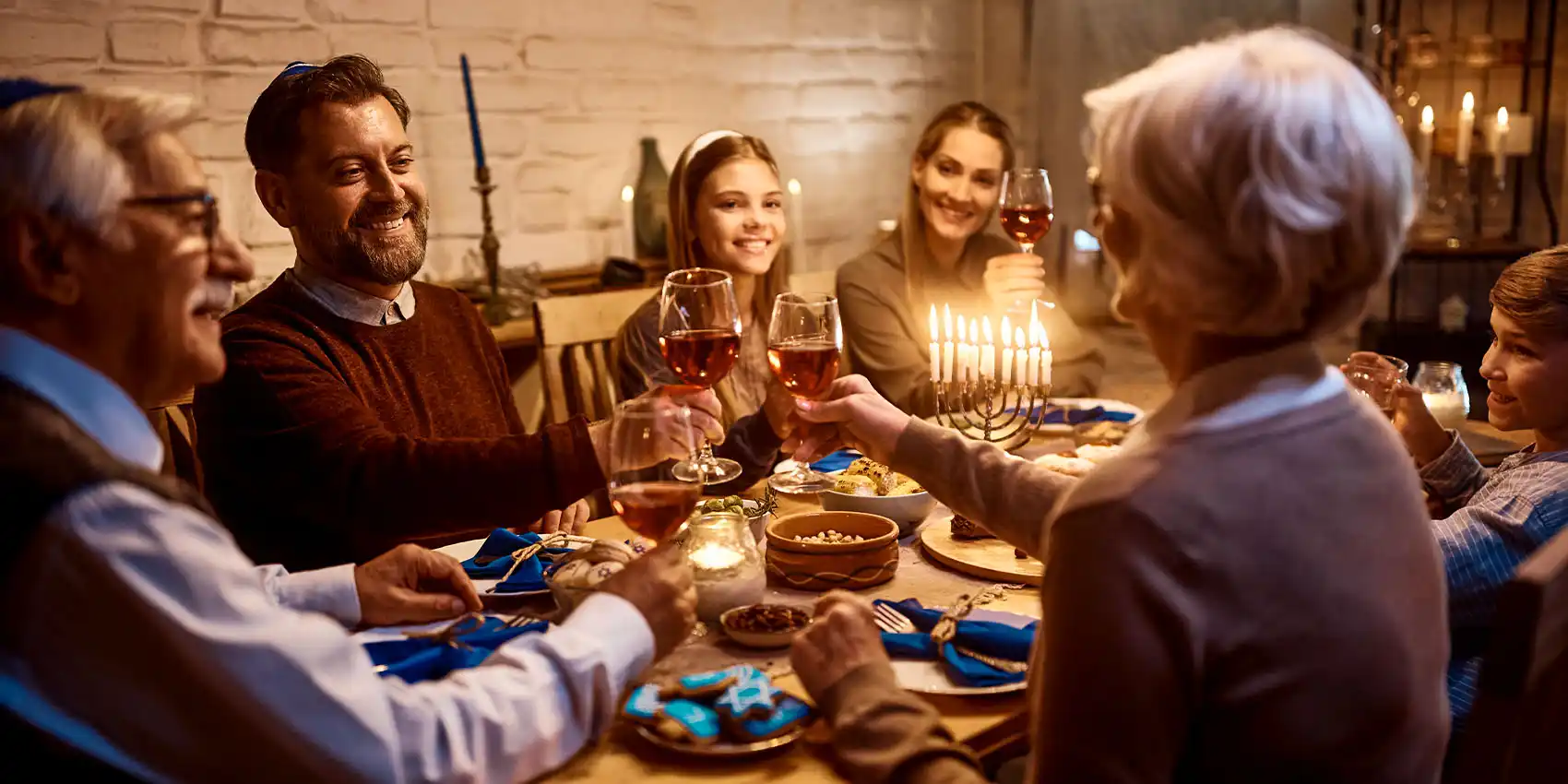Hanukkah is a joyful Jewish festival commemorating the rededication of the Second Temple in Jerusalem after the Maccabean Revolt. The Jews reclaimed their Temple from the Syrians, and cleansed and dedicated it once again for worship.
It is known as the festival of lights that symbolizes hope, perseverance, and the triumph of light over darkness. The holiday is celebrated to advise Jews to rededicate themselves to keep the fire of Judaism and Jewish culture alive to pass it on to the next generation.
In this blog, I will explore the festival in depth and convey the warmth and richness of the Hanukkah celebration and tradition.
History and Origins of Hanukkah
In this section, let us get to know more about the history and origins of the Hanukkah festival, which is also called Chanukah. There were a few historical events that led to the establishment of the festival. The main event is the Maccabean Revolt that started in 167 B.C.E.
The Syrian-Greeks had invaded the homeland of the Jews and conquered Jerusalem, where the second Jewish Temple was situated. They desecrated the Temple and enforced laws preventing the practice of Judaism.
The Jews started rebelling against the Syrian-Greeks and fought back against their army in the Maccabean Revolt. After winning back Jerusalem and their homeland, the Jews found the Temple in a destroyed state.
The people cleansed the Temple and lit a candle called the Hanukkah menorah to consecrate the Temple once again. However, they had to use a special oil for this and at the moment, they had just enough to sustain the flame for one day.
Miraculously, the oil lasted for eight days. This gave them time to prepare more oil to keep the candle lit. This miracle of the Hanukkah candles became the basis for the festival of lights. Today, the Hanukkah menorah is a candelabrum of seven branches that is used to celebrate this festival.
The main aspect of the Hanukkah meaning is about paying respect to the resistance of the Jews and their endurance against oppression. The victory against the Syrian-Greeks is a sign of preservation of Jewish identity and heritage, no matter the odds.
Symbols and Rituals in Hanukkah
To know more about the festival, you must also learn the various Hanukkah symbols and rituals used. The main rituals of the festival include lighting the menorah, spinning the dreidel, and enjoying the festive foods.
The lighting of the menorah holds historical significance as we discussed in the previous section. Today, this is the primary ritual of the festival. During the eight days of the festival, a candle is lit on each night to remember the miracle of the menorah. Hanukkah blessings are said during the lighting of the first candle and then for subsequent candles every night of the festival.
A special ninth candle called shamash or helper candle is used to light the candles instead of a random lighter. This candle shows that one person is enough to start a cycle of kindness and compassion through helping and uplifting others, and become the light of the world.
Another ritual in the Hanukkah festival is playing dreidel. The game uses a four-sided spinning top, each side labeled with Hebrew letters. Nun, Gimmel, Hei and Shin are the four letters. These are acronyms for “Nes Gadol Hayah Sham”, which can be translated as “a great miracle happened there.” This is in reference to the Hanukkah miracle of candle oil.
Players spin the dreidel top taking turns and act based on the letters that show up. Nun means do nothing, Hei means take half the pot of tokens, Shin means to add one token to the pot and Gimel means you win all the tokens. The significance of the game of dreidel is that it helped Jews to preserve their language and culture at a time when studying the Torah was prohibited. It signifies the courage and resilience of the Jews.
When it comes to festive meals, traditional foods such as latkes/potato pancakes and sufganiyot/jelly-filled donuts are shared among the people. The focal point of the festival is the menorah oil that lasted for eight days miraculously. Therefore, oil-fried foods are used to celebrate the festival and hence these traditional fried foods are the highlight of the Chanukah festival.
Hanukkah Celebration and Customs
Here, let us understand how the festival is celebrated and the various customs involved. The Chanukah festival is celebrated for eight days and the dates keep varying every year. It usually falls in the months of December and January.
The celebrations mostly happen through family gatherings, where various traditions and rituals are observed. These mostly include lighting of menorah during the night, trading of gifts and enjoying good Hanukkah food.
Apart from family gatherings, community events are another way of celebrating this festival. Jewish communities host several events such as public menorah lighting, Dreidel game tournament, Hanukkah markets, charity activities and many more. Some communities also include events like concerts, lectures, live music and dancing.
Jewish communities around the world have different customs and practices when it comes to celebrating this festival. Let me discuss some of them now. In Israel, it is celebrated as a national holiday. Hanukkah decorations are seen in all the public places. Many towns and cities host events like music, dancing and other Jewish activities.
The celebration in the United States is widely recognized, both by Jewish and non-Jewish people. Families exchange Hanukkah gifts with each other and there are communities that host public celebrations along with live music.
Italians indulge in fried artichokes on this holiday. The communities there host lectures, concerts and other cultural events. In Iran, they celebrate it through a festival called Chelleh Neshini, where families light candles together, enjoy traditional oil-cooked foods and exchange gifts.
Hanukkah/Chanukah Today
The festival in present time isn’t any different from how it was celebrated before. It still includes the lighting of candles, enjoyment of traditional foods, playing games, and exchanging gifts.
Chanukah has played a significant role in bringing back the Jewish identity and has helped in the cultural preservation by the commemoration of the miraculous menorah symbol of the candle oil. The candle oil had miraculously lasted eight days in the Temple showing the endurance of the Jewish faith.
The festival has no direct correlation to Christmas or Kwanzaa. However, they often share the same dates or timelines of their festivals. Some of the Jews also exchange gifts with non-Jewish people during the festival, to celebrate a broader cultural gathering of the religions and honor those cultures who do not follow the same beliefs as them.
Since this is a joyous festival of lights, you might decide to celebrate this festival by having a vacation. If you choose to be in the Poconos during the Hanukkah festival, then HolidayKeepers provides some kosher vacation rentals to stay in while celebrating the festival with your family.
Conclusion
Hanukkah is a festival of lights that celebrates the timeless themes of faith, perseverance, and joy. It showcases the persistence of the Jewish people in upholding their culture and faith through all the odds against them. The festival becomes a good reason for families to come together and celebrate the triumph of their traditions and heritage through history.
Embrace the spirit of the festival of Hanukkah in your lives, by fostering the qualities of unity, compassion, and gratitude. I wish you all a meaningful and happy Hanukkah, filled with love, light and blessings for the year ahead.
If you are planning to travel to the Poconos for an amazing vacation, HolidayKeepers offer a variety of luxury homes and vacation rentals to help you with your stay. The vacation rentals have ample amenities so that you can have a convenient vacation. Contact us to know more about this.
FAQs
Q: What exactly is the distinction between Hanukkah and Chanukah?
A: There is no distinction between Hanukkah and Chanukah – they are just two different spellings of the same holiday, which commemorates the rededication of the Second Temple in Jerusalem during the 2nd century BCE.
Q: What is the menorah lighting ritual?
A: The menorah lighting ritual involves lighting a special nine-branched candelabrum called a “hanukkiah” each night of Hanukkah, adding one candle each night until all eight candles are lit on the final night. The ninth branch, called the “shamash,” is used to light the other candles.
Q: What are the traditional gifts given during Hanukkah/Chanukah?
A: There are no traditional gifts that are required to be given during Hanukkah/Chanukah, but it has become a common practice to exchange gifts, especially among children. Some popular gifts include chocolate coins (gelt), dreidels, and books.
Q: What are some of the most well-known Hanukkah/Chanukah songs?
A: Some of the most well-known Hanukkah/Chanukah songs include “Ma’oz Tzur” (Rock of Ages), “Hanukkah, Oh Hanukkah,” and “I Have a Little Dreidel.”
Q: Do other countries observe Hanukkah/Chanukah?
A: While Hanukkah/Chanukah is primarily observed by Jewish communities, it has gained popularity in many other countries, including the United States, Canada, and parts of Europe. It is not an official holiday in most countries, but it is recognized and celebrated by many Jewish communities around the world.




